
by scott.gillum | Mar 20, 2020 | 2020, Opinion
by Scott Gillum
Estimated read time: 3 Minutes
Making Working from Home, Work
Barking dogs, crying babies, toddlers toddling, welcome to the reality of working from home.
Since our founding 3 years ago, our teams have been living this life. Here are 3 tips to help you make the adjustment.
- Get used to and learn how to live with working odd hours. If you’re accustomed to a routine of “working hours” in the office, you can kiss that goodbye if your children are at home.
Channel your “inner Gandhi” for patience and flexibility. Work when you can find the calm. Early mornings, evenings, and quiet moments in between.
Managers be flexible on your expectations on deliverables and due dates. You may see your team disappear during a good portion of the day.
- Count on technical issues, unplanned and spontaneous interruptions, and scheduling issues with conference calls.
In fact, you may be better off adopting the attitude that something will go wrong as the default.
- Everyone on camera for video calls…except when someone feels like they don’t want to be.
I’ve seen some posts that organizations mandate it, but the reality of our situation is that you, and/or your home office, may be a complete sh*t show at some point during the day. It happens…and we can deal with you not being seen on a call.
Part II – Now that you’ve been at this for a couple of weeks here are a few other things to consider.
- Wall clock to body clock work hours – You may be aware that your energy level and passion vary based on the time of day, now that you’re out of the office you can do something about it. Instead of reaching for another cup of coffee, go for a walk (and take the dog with you) change your work location — it’s spring now and the weather is great for working outside. Working will become more feel driven than time driven.
- Listen to your body – also by this point you may have noticed that your makeshift office isn’t exactly ergonomically designed. Pay attention to how long you sit and/or have your head in one position. Don’t worry if you forget, your body will remind you the next day.
- Reboot your modem and wireless router – you may have also noticed that your bandwidth has slowed. Consumer Reports recommends rebooting once a month, especially if you have added devices to the network.
- Update your work office – now that everyone is out of it, how could you use this time to your advantage. It could be a great time to paint, reorganize the furniture, update the lighting, etc.
Good luck and stay safe!
Making Working from Home, Work…
Follow along for more tips on marketing, business, and thinking differently delivered directly to your inbox, subscribe to our newsletter at www.carbondesign.com/subscribe.

by scott.gillum | Jan 21, 2020 | 2020, Sales
by Scott Gillum
Estimated read time: 8 Minutes
“The best sellers are the people who make the product,” said my son as we were walking out of a store in a quaint town in Los Cabos, Mexico.
It was an interesting comment made after I had just purchased a pair of earrings for my wife in a jewelry boutique. The buying experience turned out to be an interesting “Goldilocks and the Three Bears” sales story, or in our case, the “Tourist and the Four Brothers.”
A few nights prior, after enjoying dinner in town, we walked the streets visiting local shops. The first jewelry store we visited was run by one of four brothers, all jewelry designers who had followed their father into the business. Each brother had their own style, which was reflected in their jewelry, shop decor and personalities.
The first brother’s store was white and teal, very similar to Tiffany’s. The display cases were decorated with high-end tequila bottles sprinkled among the jewelry, which immediately caught my eye. My wife, perusing the counters, settled in an area with rings while I chatted with the clerk behind the counter about the family and their business.
In working with my wife the sales person failed to realize that he wasn’t selling to a naive tourist but rather a very knowledgeable buyer who at one point in her career had managed a jewelry department for a high end retailer. A mistake often made by sales people who fail to do research on their potential buyers. As he pitched her on a ring she had intentionally requested to see, he failed to notice she was wearing one similar.
When buyers are in an unfamiliar environment, like we were, they will seek to find a frame of reference or an “anchor.” Something that they can connect to their knowledge base to aid in decision making. Being new to the store, and pricing in pesos, my wife “anchored” on a familiar ring. Trying on the ring she was able to assess that it was roughly twice the price and half the weight as hers. Now that she had a reference point, she determined that the store markup was about twice that of a US store.
The second brother’s store was bigger and had a vast selection of jewelry (and no tequila). The clerk, a niece of the designer, greeted us and carried around her calculator while following us around the store. A not so subtle message that she was ready to make a deal.
My wife found an area of rings and picked one out. As she asked questions, the store clerk mentioned they were having a promotion. She then tried to discount to close the deal which kept falling as we were walking towards the door. By the time we left, the price had fallen 40%, with an offer to call her Uncle to get maybe an even better price.
The last store we visited was white, simple and elegant. It didn’t contain a lot of inventory, in fact, one of the display cases was completely empty. The person working behind the desk was not a sales clerk, but an assistant designer who introduced us to the youngest brother in the family and owner of the store. He was the designer and told us about his creations apologizing for the lack of inventory.
We talked about his life, his education in London, and the fact that he didn’t want to get into the family business, but his love of designing drew him in. His real passion was designing furniture which he hoped to start retailing soon.
My wife found a pair of earrings and tried them on. As she did he explained the process used to give the silver hoops their shimmer along with the details about the gems used to enhance them. He brought over other silver earrings and pointed out the differences in the design process.
Deciding to purchase the earrings, we asked if they had a “promotion.” He said that Visa or Mastercard were offering a 10% discount on a purchase. The card companies, not him, offered the promotion.
As we were paying, I noticed a unique bottle of tequila sitting behind the desk. A dark blue bottle with carved symbols of the tequila making process along with the history of the Los Cabos area. He said it appealed to him “because as a designer” he appreciated the craftsmanship of the bottle. I loved the story (and the taste) of the tequila and he offered to connect me with the owner who lived locally to secure a bottle.
The first store tried to position itself as the Mexican version of Tiffany’s. The problem was, we had no prior exposure to the brand, so the brand promise and value were empty. The second store offered choice and price but made us question it’s authenticity and quality. (Given the amount of products offered we suspected the owner couldn’t have designed everything, and the discount made us question if the stone used in the ring was natural or man made.)
Later that night, I got a text from the store owner where we made our purchase, sharing the price and location to pick up the tequila. He didn’t have to follow up with me after we made the purchase but he did. It wasn’t an empty promise made to close the deal which happens far too often, but a genuine gesture.
In the end, my wife received a piece of jewelry she loves and I got a unique bottle of tequila but what we really bought, was the owner of the store. For the 20 minutes we spent in the store, a connection and relationship were formed through storytelling. It was both authentic and passionate, building a foundation of trust.
The experience made me reflect on the effectiveness of our sales and marketing efforts. What if we could train our sales people to act like “owners” or “designers” of the product; how might that impact their success? That question prompted another one which was, how many sales people ever receive training by the product group, or really know or understand the story behind the product or service they sell.
We can’t give the passion that comes with the pride in ownership, but we can train them to be storytellers, because as we experienced, buyers don’t buy from you, they buy into you.
As for the fourth brother, his store never opened. Guess it’s true, showing up is half the battle.
Follow along for more tips on marketing, business, and thinking differently delivered directly to your inbox, subscribe to our newsletter at www.carbondesign.com/subscribe.

by scott.gillum | Jan 28, 2019 | 2019, Marketing
By Glen Drummond
How far have we really come since the Cluetrain Manifesto? It’s sad to admit, but arguably true, that much B2B marketing still flirts with mediocrity. Why? Part of what contributes to the mediocrity is the tendency of B2B marketers to race towards “best practices,” seeking, paradoxically, to achieve brand differentiation by imitating the past practices of competitors and predecessors.
In marketing strategy, the perceived safety of doing what others have done is an illusion. “Best practices” are properly reserved for simple situations that can be dealt with according to simple categorical logic. Branding problems can rarely be reduced to such simplicity without overlooking dimensions of the situation. Sometimes those dimensions are critical factors in success or failure.
Once we acknowledge that “strategy by imitation of practices” has a poor prognosis, it’s a short step from there to go looking for a theoretical foundation for action.
Our theoretical foundation takes the form of a “dissenting opinion” towards a handful of (largely unexamined) theories that are implicit in practices and advice widely found in the B2B marketing space. At Carbon, we exploit this contrast as an engine of strategic differentiation for our clients. Here are 5 components of that engine:
1) People have a deep and profound need as social animals to belong to groups, to achieve and maintain status within groups, and to construct and signal identity in the context of these groups.
Few people would disagree, but just the same, this point of view on motivation is still mostly ignored in B2B marketing and sales strategies that emphasize rational business benefits. As deals get bigger, and buying committees get larger, the error of underestimating this factor in motivation becomes more regrettable.
2) Most of the time the human mind is operating in a state characterized by a fast, non-deductive, association-driven path.
This view, deried from behavioral economics, stands directly opposed to the classical economic imagination of people as “rational actors.” Something at stake in this dispute is our understanding of how we best achieve desired meanings in the mind of our customer. Should we focus on telling people what we’d like them to believe, or should we design a coherent fabric of associations and invite people to participate in constructing meaning from it? Most zig, we zag.
3) B2B buying is a group decision, and group decisions are chaotic and non-linear. On good days they resemble the pursuit of design problems. On bad days they resemble a garbage can.
This take on decision theory (and thus buying) stands in contrast to the (usually unexamined) assumption that business decisions are pursued in a logical process that begins with a stable set of identities, goals preferences, and advances in a straight line towards the optimization of outcomes. This assumption is perfectly aligned with the metaphors of “funnel” and “buying journey.” Just not with reality.
4) Experiences are meaning-making opportunities. Stimulus and response are separated by a meaning-making operation.
This stance is opposed to the mechanistic behaviorism that lurks beneath notions like “monetizing eyeballs,” “unique selling propositions” and “the b2b content factory.” Notions like these come and go, but the underlying assumption, for all its flaws, seems hard to kill.
5) Firmographics and role titles are more useful for counting potential customers than they are for building strategies that move those customers to action.
This stance contrasts the segmentation assumptions of most B2B marketing and sales organizations. We see that as limiting in two ways – first, it’s non-differentiating since firmographics and role titles are no mystery to competitors. And second this knowledge is not as helpful as people generally imagine in persuading prospective customers to adopt a belief or a behavior.
We don’t dispute that strategies resting on contrary philosophies have worked in the past. But looking forward, we see value migrating from tangibles to experiences. B2B buying groups will grow larger in the face of more difficult decisions. The pace of change and disruption will pick up. B2B commercial opportunities will increasingly be initiated by customers and mediated through inbound channels as the first point of contact. As a result, this is an environment that favors our “dissenting view.”
by scott.gillum | Jan 4, 2015 | 2015
It’s the time of the year to look back over the last 12 months and create a “best of” list. This year I’ve pulled the most popular posts from five different sites; Adage, Business2Community, Forbes, Fortune and LinkedIn. In addition, I’ve thrown in a few other noteworthy nuggets from the year at the end of the post.
Adage – Why Apple Pay Could be Huge, And It’s Not What You Think explored the potential upside of Apple Pay as an advertising platform. It sparked the most conversation, and debate, on Twitter. Time will tell if they this strategy will come to fruition.
Business2Community – 5 Key Tips and Da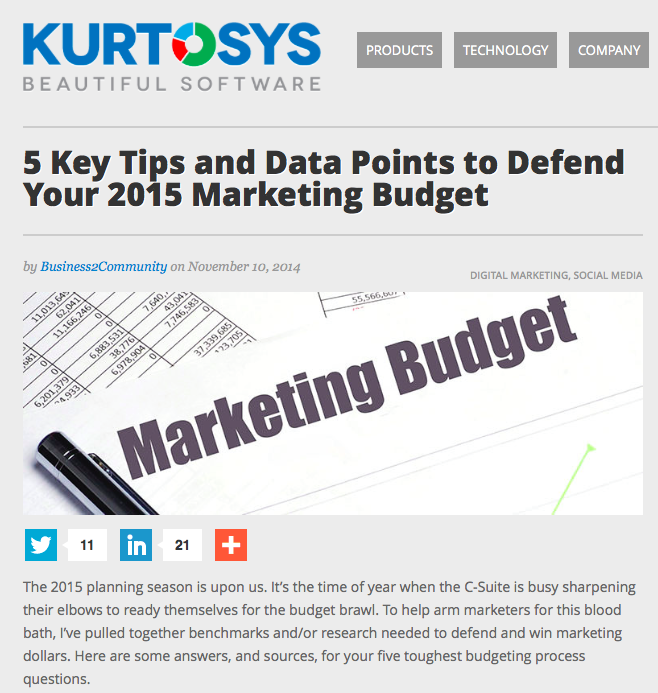 ta Points to Defend You 2015 Marketing Budget. The last post of the year required the most man hours, and it was the most reposted story of the year. It offers marketers help with their 2015 planning activities in the form of free research and benchmark data.
ta Points to Defend You 2015 Marketing Budget. The last post of the year required the most man hours, and it was the most reposted story of the year. It offers marketers help with their 2015 planning activities in the form of free research and benchmark data.
Forbes -the most popular and shared post of the year, Could Falling Test Scores Be a Good Thing for the US? explores the link between test scores and success in business. It also highlights the risk associated with over emphasizing left brain analytic skill development, outlined by Sir Ken Robinson in his Ted Talk video Do Schools Kill Creativity? The endorsement of Marc Andreessen certainly played a big role in the popularity of the post.
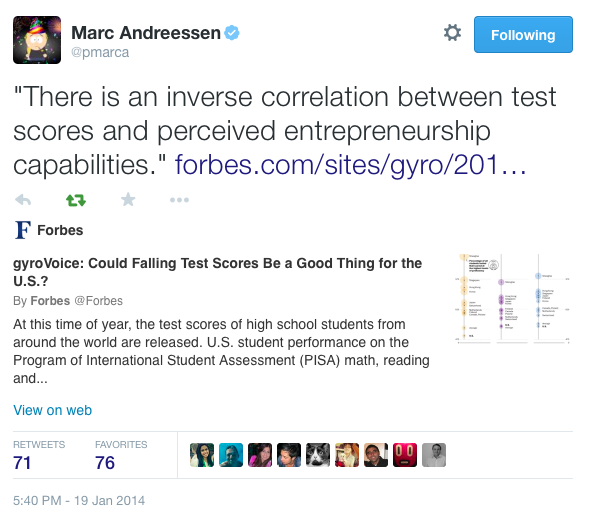
Fortune – Are Marketers Measuring the Right Things was the first post I wrote for our new partnership with Fortune. It profiles the efforts of Ciena, a networking company, to elevate marketings role, and importance, within the organization. The post highlights an unique survey tool used to gather feedback from the sales organization on the performance of marketing (see the dashboard below).
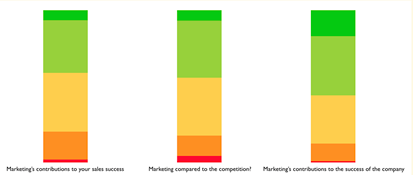
LInkedIn – 2014 marked my first year publishing on LinkedIn. Based on my experience so far, I’m not convince it will viable platform for content unless it becomes better policed. Too much promotional material seems is making its way on to it. At this point, I’m not sure I’ll continue to post.
That said, the most popular post on LinkedIn was also one of the most popular on Adage. The Keys to Differentiating Your Company From Others provides tips on how marketers can humanize their corporate brand to better resonate with audiences. It also identifies one of the common flaws of B2B communication – thinking that what you sell…is who you are. Hopefully, it also helped generated a new client for a follower.

Bonus Stuff
A couple of other noteworthy happenings from the year.
Moving on up.
The Next Generation of Apps Will Be All About You post that ran on Advertising Age was reprinted in the Sept/Oct version of The Portal magazine, a bi-monthly publication produced by the International Association of Movers.
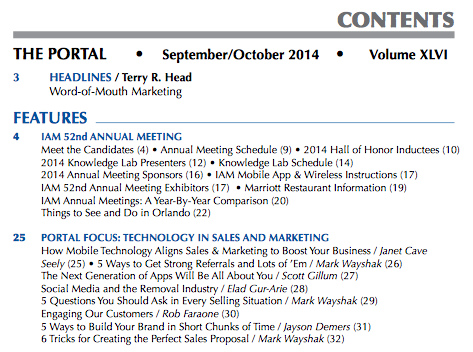 Taking Center Stage
Taking Center Stage
Karen Walker, SVP at Cisco, highlighted my post Everything We Thought We Knew About B2B Marketing is Wrong in her presentation at this year BMA member meeting in Chicago. The post now has close to 70,000 views.
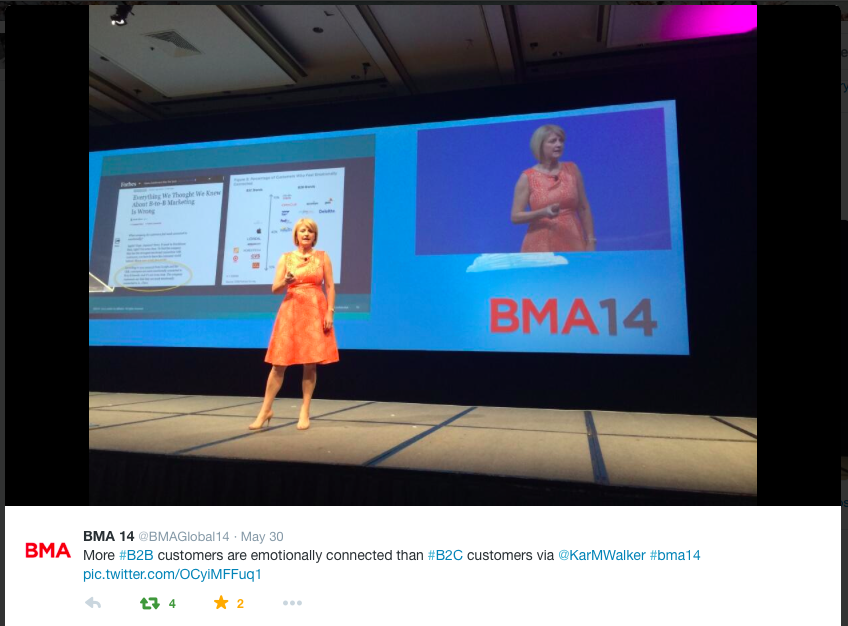
Happy New Year! Here’s to an exciting year to come.
by scott.gillum | Jul 30, 2012 | 2009, Marketing
Original post date July 16, 2009
I’m about to share with you the secret formula for; 1) creating a rock solid, compelling value proposition (for products, services, solutions, etc.) and, 2) aligning (enterprise wide) your corporate communications. It will seem like a very simple approach, and it is, but once you try to get consistent answers from the organization to the following questions (in order) you will understand why this is so challenging…and why so many companies fail.
Keep this in mind, effective communication to customers must happen through a consistent delivery of the right message, to the right customer, at the right time, in the right channels to facilitate effective, efficient dialogue.
This is how you do it. You have to be able to collectively (with the right internal groups) answer the following five questions in order:
- Who? – what audience/segment are you targeting, and why
- What? – what do you want/have to say to that segment that is relevant
- Why? – why would they listen
- When? – when do you contact them, and how often
- Where? – where do they want to receive the message
Sounds simple right? Here are a list of challenges you will face when go through the process:
- Who – right off the bat, you will find folks arguing about your target audience, the segmentation approach, the segments, etc.
- What – oh, you’ll have plenty of things you what to tell whatever audience you settle on but you will struggle with relevancy
- Why – now comes the killer question…why would they listen? Seen this question bring grown men (and women) to their knees. The reasons are many; Marketers don’t understand the products, products aren’t differentiated, etc. Getting this question right is the key to the whole process.
- When – the challenge is deciding on at what point in a sales process, a marketing campaign, events, etc., and the frequency of contact. Touch them too often and/or at the wrong point you’ll get opt-outs, too infrequently, you’ll get no mindshare.
- Where – notice that I said, “they”, and not “you” on where the communication happens. Yes, it’s about your customer and where they go for information not where you want to put it. Find out where your audience goes to get information and/or determine their perference for receiving it. The othe challenge is ensuring that the message fits the channel. Certain messages/value proposition, etc. fit a certain channel better than others. It’s worth the time to figure this out.
This approach creates an execellent output but it will take time, discipline and many iterations to get right…good luck.




 ta Points to Defend You 2015 Marketing Budget
ta Points to Defend You 2015 Marketing Budget









